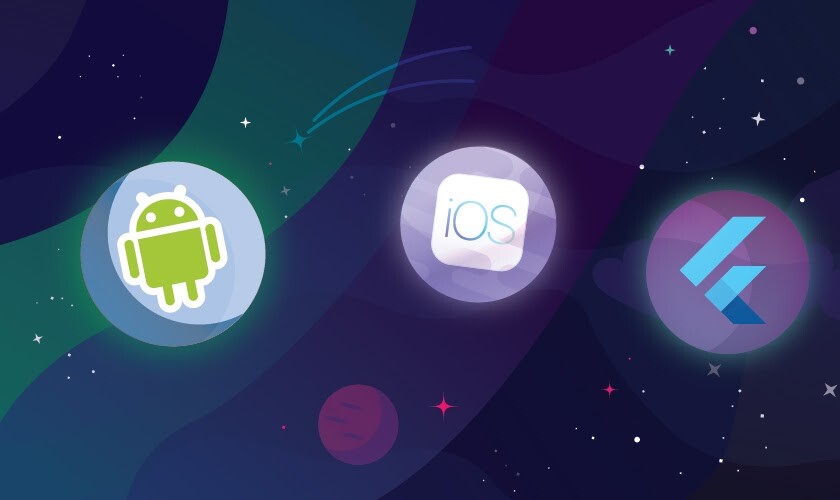When starting a mobile application development project there is always a question – is it better to opt for cross-platform development or stick with native? Many choose cross-platform development because it allows having just one development team for all platforms, accelerates the process of development, and cuts costs.
There are a number of frameworks, SDKs, and other tools for cross-platform mobile development, and choosing the right one can get difficult, as well as deciding between native and cross-platform development approach.
To help you make a choiсe, in this article we will examine a new member of cross-platform development community Flutter SDK and compare it to two popular technologies – React Native and Xamarin, as well as to native development. The mobile development community pays a lot of attention to Flutter development right now as this SDK promises unique benefits that other SDKs cannot provide. Yet it has its own disadvantages, which we will examine too.
Flutter VS React Native
React Native may be the strongest contestant here. Comparing to Flutter, it has a long history and a larger community along with wider adoption. But even such a popular and solid technology can be dethroned by a budding rookie.
Pros of Flutter
-
Efficient performance
Flutter is built on Dart, a quite performant language that Google has been using for some time already to build its own products. There are too many factors to definitely judge whether one technology performs better than the other one, but Dart is considered to drive the performance of Flutter better. Also, React Native has to use a JavaScript bridge to access native device components, which increases the application response time. Flutter, on the other hand, uses its own Dart bridge that accelerates running time.
In addition, applications built with Flutter are compiled with C/C++ libraries, which resemble machine language and provide better native performance. Note that the whole application is compiled that way, not just UI elements.
-
Good documentation
Google is famous for its exhaustive documentation, and Flutter’s one is not an exception. The documentation is thorough and very useful for both experienced developers and junior specialists.
Also, there is a large community of enthusiasts who create tutorials and complement documentation, so that newcomers are never puzzled.
-
Strong architecture
Flutter architecture is rather huge because it has everything inbuilt to develop a mobile application from beginning to end. It uses the Dart bridge to access the device’s native modules and does not have to call a JavaScript bridge as React Native does.
Design standards for Android and iOS, Material Design and Cupertino respectively, are also built-in so that in terms of the appearance of applications you are backed too. There is a Skia engine on C++ that has all the needed protocols, channels, and compositions at hand.
Cons of Flutter
-
Weaker ecosystem
In terms of ecosystem, React Native is way ahead Flutter. In basic terms, it just had more time to establish tons of packages. But it is still not over for Flutter – the SDK is catching up with the pace and offers a number of core packages for mobile development. The most powerful driver of ecosystem development is, again, the community with its strong dedication.
-
New language
Despite all benefits that Dart has, including performance and easy learning curve, JavaScript is still a more popular and widespread language in the development community. It is commonly used in major popular web development frameworks adopted by the numbers of companies. JavaScript provides developers with the ability to create nearly everything, and this is the reason why most choose React Native over other frameworks.
As the result, Flutter wins because of its better and faster performance, detailed documentation, and an all-inclusive architecture. Yet React Native is better in terms of an ecosystem and development language.

Now we are going to examine the next contestant Xamarin, an open-source mobile development framework run by Microsoft.
Flutter VS Xamarin
Both Flutter and Xamarin are open-source and run by large-caps. Xamarin SDK allows for developing cross-platform apps for Android, iOS, and Windows Mobile with a single C# codebase. It also has a Xamarin Testing Cloud for application testing. Let’s examine how Flutter and Xamarin are competing.
Pros of Flutter
-
Convenient UI design
Flutter provides a large number of layouts, widgets, and platforms to create graphic elements in 2D, support animation or different effects. Flutter’s set of widgets is very impressive especially compared to other technologies, including Xamarin. It allows for building interfaces using pre-designed blocks that follow Material Design and Cupertino rules, which accelerate UI development.
Xamarin loses this point due to platforms’ regular updates. This SDK uses native UI components and has to adapt each time when there is an update. This also makes Xamarin not suitable for UI code reuse.
-
Better developer experience
Developers love the Hot Reload feature of Flutter. It allows them to experiment with the UI, add and change features, perform better and faster bug fixing without losing the state of the application. Hot Reload just applies the changes immediately and displays them in the UI directly.
Another thing that takes care for developers is the ability to access native features like third-party components and reuse native code in Swift, Java, and others.
Nevertheless, Xamarin also tries to provide developers with useful and handy features like life reload – an equivalent to Hot Reload – yet the majority of them are accessible only via pay subscription.
-
High integrability
The integration of third-party components such as libraries is implemented in Flutter way better than in Xamarin. Thou Flutter lacks such libraries at the moment, the number still rises and Flutter’s ability to integrate third-party components is better than Xamarin.
Cons of Flutter
-
New programming language and low code reusability
As said before, Flutters allows for UI code reusability. But beyond that, the situation is not so bright, as Flutter allows developers to reuse up to 70% of the code on average. What is more, its development language Dart is not a popular and widespread one.
Xamarin does a better job here. It utilized C# which is widely used in a development community. Specialists who already work with C# and .NET can easily use Xamarin and reuse about 96% of the code if Xamarin. Forms were leveraged. A Flutter plus Dart bundle does not provide the same level of reusability.
-
Lack of maturity
The stable release of Flutter was on December 4, 2018. The SDK is still developing and very new to the market of cross-platform mobile development, which can’t be said for Xamarin. It has been there for years and has matured – now 7.4% of professional developers use Xamarin.
Also, there is no way to know whether the SDK will be popular and useful in the future, hence no way of knowing if it is worth migrating to Flutter completely.
To sum up, Flutter wins again because of UI design benefits, better and more pleasant developer experience, and a higher level of integrability with third-party components. But let’s not forget that it has a lot to improve in terms of a programming language and code reusability, and a level of maturity.

And now we can eventually compare Flutter cross-platform development with the most solid approach – native application development, which implies creating a separate application for each platform.
Flutter VS Native Development
Many native developers are skeptical about cross-platform development. They report experiencing troubles with scrolling speed and button behavior, which both work perfectly in native apps. When Flutter appeared the developers were skeptical again because of an additional problem – this SDK was new and not yet mature, which could cause even more performance issues. But specialists who tried Flutter often change their minds.
Pros of Flutter
-
One codebase
An obvious but important benefit of cross-platform mobile development on average is having to code once and run it everywhere. It cuts development, design, and testing costs and saves time. Flutter provides developers with Dart to code cross-platform apps. Dart is a language that Google uses for its inner projects and is easy to learn for those who are already familiar with structured languages like C or Java and object-oriented programming.
-
Less testing
When there is one codebase for several apps QA engineers do not have to test these apps separately – just check how the codebase performs for all the apps and they are ready to go. This also cuts costs on testing and allows for hiring a smaller development team.
Cons of Flutter
-
Better performance
Since the technologies developers use for native development are platform-specific, the native code of mobile applications gets full access to the target device’s operating system and functionality. The easier the interaction between the app and the device and operating system, the less the delays between requests and responses, which results in faster app performance. This is the most evident when rendering graphics or other media content. Building native apps also reduces the risk of app crashes and freezes.
But note that Flutter is considered to provide a native-like performance nearly indistinguishable from apps written for one target platform only.
-
Better positioning in application stores
Native apps provide users with excellent performance which results in high-quality user experience. Application markets value user experience and give good applications a higher positive rating which leads to greater visibility in the store.
There is no approach that trumps the other, and developers should choose whether they value faster development in terms of one codebase for all apps and less testing, or a better performance and app market positioning. The choice should be tailored accordingly.

And the Winner Is
Flutter is definitely a technology you should try for your next cross-platform mobile application. It has lots of benefits over other popular technologies and can beat a native development approach, but one should also consider the drawbacks.

Mobile Development Team Lead at HQSoftware
A highly skilled mobile developer with 12 years of experience and a passion to iOS apps. Has a deep understanding of user interface design best practices, possesses expertise in cross-platform mobile development.
Related Posts
View All
We are open to seeing your business needs and determining the best solution. Complete this form, and receive a free personalized proposal from your dedicated manager.

Sergei Vardomatski
Founder






